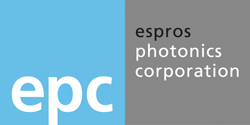Time-of-Flight principle
We at ESPROS are the leading specialists in the 3D Time-of-flight technology. A time-of-flight camera (TOF camera) is a range imaging camera system measuring the time-of-flight of a light signal between the camera and the subject for each point of the image. Compared to 3D laser scanning methods for capturing 3D images, TOF cameras operate very quickly, providing up to 250 images per second or more. In addition, they offer much higher spacial resolution than radar, ultrasonic sensors or stereo cams. Further advantages of the Time-of-flight can be seen, as depicted in the image here.
Products with Time-of-flight for civil applications began to emerge around 2000 as the semiconductor processes became fast enough for such devices. Operating ranges of a few centimeters up to several kilometers. Distance resolution is from sub-millimeter to tens of centimeters. The lateral resolution of time-of-flight cameras is generally low compared to standard 2D video cameras with most commercially available devices at 320 x 240 pixels or less. Compared to 3D laser scanning methods for capturing 3D images, TOF cameras operate very quickly, providing up to 250 images per second or more.
I had a dream:
As far back as 1985 ESPROS founder, Beat de Coi was one of the first people to recognize the tremendous potential of time-of-Flight as the technological basis for sensors. “That’s when I made it my goal, to design sensors based on 3D Time-of-flight imaging (3D-TOF). At this time, the term TOF did not exist at all. Measuring distance by acquiring the elapsed time of light that travels through space was called LIDAR (Light Detection And Ranging). At this time, just one distance to one point in space was considered. Imaging wasn’t a topic at all. However, my fascination was to provide something that could become a 3D camera where every pixel had the capability to measure the distance to its individual object point. In addition at that time with LIDAR concepts, a resolution in the range of one meter or so was sufficient.”
“However, the applications I had in mind were sensors which opened automatic doors and safeguarded people and goods between closing door wings of automatic doors. Such applications require a distance resolution in the centimeter range. Due to the very high propagation speed of light in space, ultra fast photoelectronic devices and electronic circuits are needed. The LIDAR technology at that time had a timing resolution in the range of a few nanoseconds which allowed to measure distances with a resolution in the range of a meter. To achieve centimeter resolution, the system had to be a hundred times faster to allow time measurement with a resolution in the tens of picoseconds. Now, more than 30 years later, 3D-TOF is a commonly used term. Several companies provide 3D-TOF imager chips and chipsets, sensor modules and cameras.”
We at ESPROS are the leading specialists in 3D time-of-Flight.
Time of flight Principle: A time-of-flight camera (TOF camera) is a range imaging camera system that resolves distance based on the known speed of light. Measuring the time-of-flight of a light signal between the camera and the subject for each point of the image. The time-of-flight camera is a class of scanner-less LiDAR, in which the entire scene is captured with each laser or light pulse as opposed to point-by-point with a laser beam such as in scanning LIDAR systems. TOF products for civil applications began to emerge around 2000 as the semiconductor processes became fast enough for such devices. Operating ranges of a few centimeters up to several kilometers. Distance resolution is from sub-millimeter to tens of centimeters. The lateral resolution of time-of-flight cameras is generally low compared to standard 2D video cameras with most commercially available devices at 320 x 240 pixels or less. Compared to 3D laser scanning methods for capturing 3D images, TOF cameras operate very quickly, providing up to 250 images per second or more.
